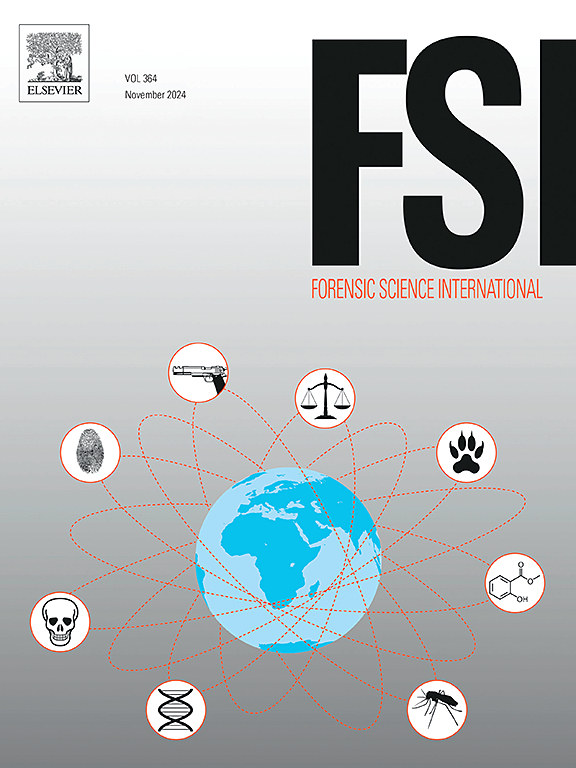Investigating the protein modification and degradation under the influence of petrol and kerosene
IF 2.2
3区 医学
Q1 MEDICINE, LEGAL
引用次数: 0
Abstract
During any crime scene investigation, forensic experts gather a variety of evidence in various forms, often degraded, contaminated, or fragmentary in nature. Arson-associated suicide or homicidal cases often result in partial or complete burning of this evidence, making the acquisition of crucial information more challenging. Proteins found in biological samples serve as crucial sources of evidence in criminal investigations due to their abundance within the body and greater stability than another biological macromolecule. Protein based technologies are gaining momentum for investigating wide range of forensic cases. In the present study, we probed different modifications in chicken protein subjecting after burning with petrol and kerosene individually. Structural changes and modifications in burnt chicken meat protein samples were analyzed by various biophysical techniques, such as absorption and fluorescence spectroscopy. Gel-based method such as electrophoresis was performed which showed different degradation patterns under the influence of petrol and kerosene. Our results showed that petrol-exposed meat sample caused higher rate of protein degradation than kerosene exposed samples, over a period of 12 days. Prevalent oxidative modifications, including increased carbonylation and decreased thiol levels were observed in both petrol and kerosene treated sample attributing oxidative stress environment caused by burning. Present study highlights that petrol is more potent in causing damage and protein modification than kerosene. Furthermore, this study elucidates the application of protein-based methods in forensic science, which can serve as a corroborative approach in ascertaining the cause of death in cases of burning, particularly where fuel has been utilized.
研究了在汽油和煤油的影响下蛋白质的修饰和降解。
在任何犯罪现场调查过程中,法医专家都会收集各种形式的证据,这些证据往往是退化的、受污染的或碎片化的。与纵火有关的自杀或杀人案件往往导致这些证据部分或全部被烧毁,这使得获取关键信息更具挑战性。在生物样品中发现的蛋白质是刑事调查的重要证据来源,因为它们在体内含量丰富,比其他生物大分子更稳定。基于蛋白质的技术在调查广泛的法医案件方面正在获得动力。在本研究中,我们分别探讨了汽油和煤油燃烧后鸡肉蛋白的不同修饰。采用各种生物物理技术,如吸收光谱和荧光光谱,分析了焦化鸡肉蛋白样品的结构变化和修饰。凝胶电泳等方法在汽油和煤油的影响下显示出不同的降解模式。我们的研究结果表明,在12天的时间里,汽油暴露的肉类样品比煤油暴露的样品导致更高的蛋白质降解率。在汽油和煤油处理的样品中观察到普遍的氧化修饰,包括羰基化增加和硫醇水平降低,这归因于燃烧引起的氧化应激环境。目前的研究强调,汽油在造成损害和蛋白质修饰方面比煤油更有效。此外,这项研究阐明了以蛋白质为基础的方法在法医科学中的应用,这种方法可以作为确定燃烧死亡原因的确证方法,特别是在使用燃料的情况下。
本文章由计算机程序翻译,如有差异,请以英文原文为准。
求助全文
约1分钟内获得全文
求助全文
来源期刊

Forensic science international
医学-医学:法
CiteScore
5.00
自引率
9.10%
发文量
285
审稿时长
49 days
期刊介绍:
Forensic Science International is the flagship journal in the prestigious Forensic Science International family, publishing the most innovative, cutting-edge, and influential contributions across the forensic sciences. Fields include: forensic pathology and histochemistry, chemistry, biochemistry and toxicology, biology, serology, odontology, psychiatry, anthropology, digital forensics, the physical sciences, firearms, and document examination, as well as investigations of value to public health in its broadest sense, and the important marginal area where science and medicine interact with the law.
The journal publishes:
Case Reports
Commentaries
Letters to the Editor
Original Research Papers (Regular Papers)
Rapid Communications
Review Articles
Technical Notes.
 求助内容:
求助内容: 应助结果提醒方式:
应助结果提醒方式:


